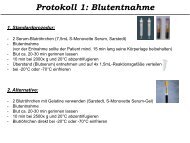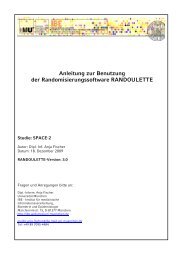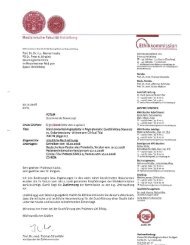CLINICAL TRIAL PROTOCOL SPACE 2 Stent ... - SPACE-2 Studie
CLINICAL TRIAL PROTOCOL SPACE 2 Stent ... - SPACE-2 Studie
CLINICAL TRIAL PROTOCOL SPACE 2 Stent ... - SPACE-2 Studie
You also want an ePaper? Increase the reach of your titles
YUMPU automatically turns print PDFs into web optimized ePapers that Google loves.
Clinical Trial Code: <strong>SPACE</strong> 2 Version: 10. October 2008 Final<br />
If a cerebrovascular outcome-event occurred an appropriate neuroimaging should be<br />
performed to distinct between possible types of stroke. In addition the mRS and NIHSS<br />
have to be assessed and documented. 30 days after symptom onset the patient has to<br />
be contacted to assess the mRS at this time point. In case of an ipsilateral<br />
cerebrovascular event in a subject randomized into the BMT-arm, patient should be<br />
considered for CEA or CAS following actual guidelines for treatment of symptomatic<br />
stenosis.<br />
Risk-factor screening, assessment of medication, and ultrasound-examinations has to<br />
be done at any follow-up visit like described above (section 5.2)<br />
5.6 Plan for treatment or care after the trial<br />
Medical treatment with risk-factor modification will be continued after the end of the<br />
follow-up period (5 years in each individual). Responsible for control of these<br />
procedures will be the general practitioner of the patient.<br />
6 ASSESMENTS<br />
6.1 Definitions<br />
Ischemic Stroke: New focal neurological deficit of vascular origin lasting more than 24<br />
hours, absence of intracranial hemorrhage upon brain imaging.<br />
Hemorrhagic Stroke: New focal neurological deficit of vascular origin lasting more than<br />
24 hours, proof of intracranial hemorrhage upon brain imaging.<br />
Ipsilateral stroke: Stroke within the territory of the treated carotid artery.<br />
Disabling stroke: Stroke leading to a disability of at least 3 on the modified Rankin scale<br />
at day 30±3 after symptom onset.<br />
Myocardial infarction: Detection of rise and/or fall of cardiac biomarkers (preferable<br />
troponin) with at least one value above the 99th percentile of the upper reference limit<br />
together with evidence of myocardial ischemia with at least one of the following [19]<br />
• Symptoms of ischemia<br />
• ECG changes indicative of new ischemia (new ST-T changes or new left bundle<br />
branch block (LBBB)<br />
• New onset of pathological Q waves in ECG<br />
• Imaging evidence of new loss of viable myocardium or new regional wall motion<br />
abnormality<br />
_______________________________________________________________________________________________________<br />
Page 22 of 49





